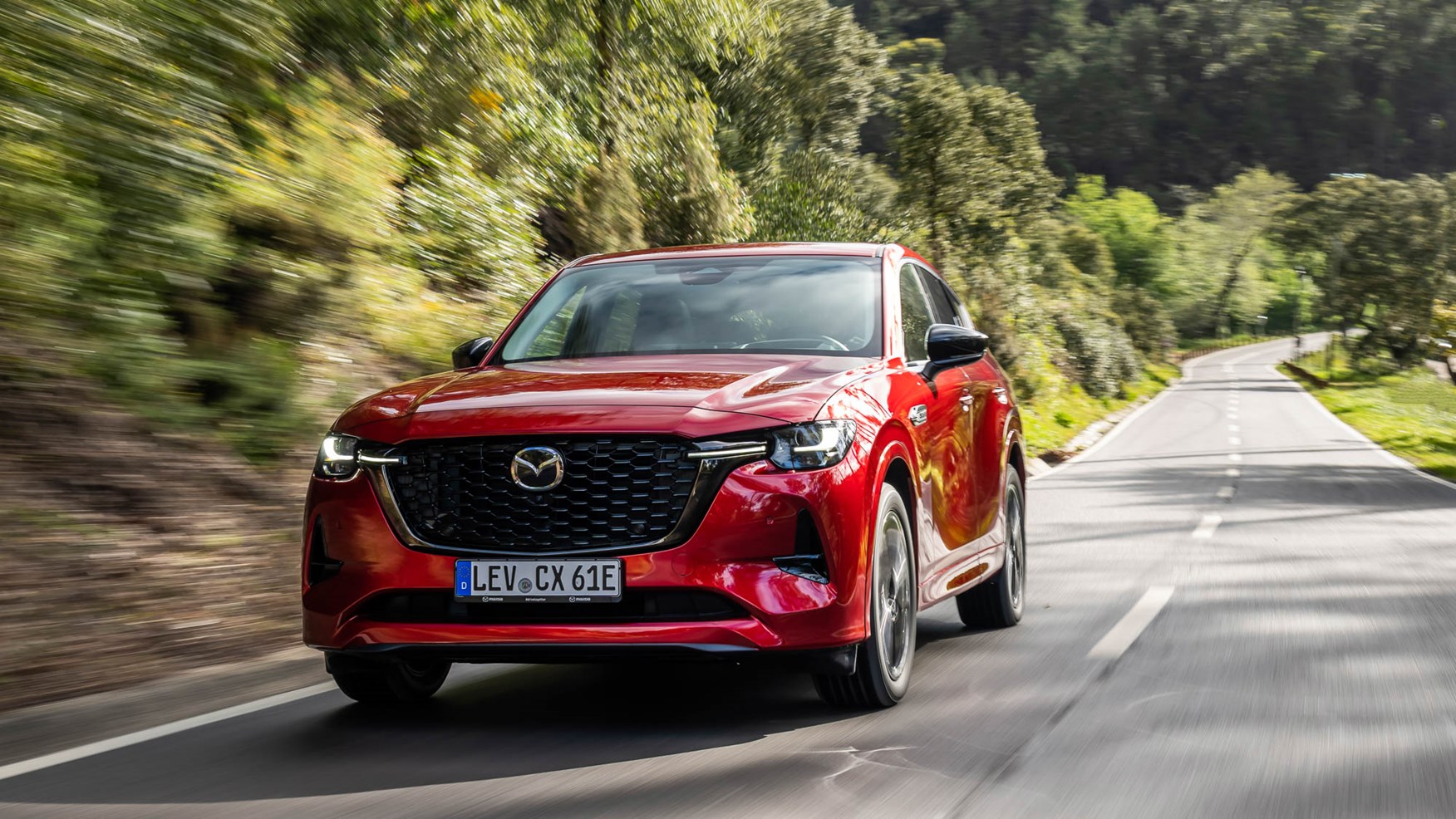As it’s Mazda, you can trust things to be done unconventionally. So in addition to the brand’s first plug-in hybrid powertrain – based around a 2.5-litre petrol and a rival to the X3 eDrive or 3008 Hybrid – comes a brand-new 3.3-litre straight-six diesel with mild hybrid assistance.
Can Mazda with its unconventional engine lineup, Kodo design language and beautifully-trimmed interior make a splash, and tempt you out of the more mainstream premium players?
What’s under the bonnet?
Where the CX-60 stands apart from most of the opposition is its in-line drivetrain configuration. The plug-in hybrid model is powered by a large-displacement 2.5-litre four-pot petrol and, which is combined with a 173bhp electric and eight-speed automatic transmission, this is Mazda’s most powerful production car yet, with 369lb ft of torque and323bhp in total.
Rather than splitting front and rear drive between multiple motors, the CX-60’s motor in hybrid form, whether plugged in or mild, takes the place of the torque convertor in an otherwise conventional automatic layout.
It delivers a claimed 39 miles of battery-only range, which is delivered by a 17.8kWh battery pack that sits under the floor between the axles. This layout leaves practicality uncompromised and the centre of gravity optimised to complement the rear-wheel drive layout.
What about the diesel?
It feels strange in 2023 to be writing about an all-new diesel engine, and stranger still to say that while it’s an inline-six with a mammoth 3.3-litre capacity that it’s capable of delivering nearly 60mpg in a car as big and heavy as the CX-60.
Two power outputs are available – a 197bhp model available in rear-wheel drive and entry-level Exclusive-Line trim only, or a more powerful 254bhp option with all-wheel drive and available in the upper two trim levels. 331lb ft means even the leaner option feels suitably muscular, and 0-62mph takes 8.4 seconds.
Mild hybrid assistance means it’s capable of shutting off and coasting while decelerating, and Mazda says that the larger capacity allows for a leaner fuel mix under greater load than, say, the 2.2-litre in the current CX-5.
That means that for a majority of normal use it’s operating at greater than 40% thermal efficiency. The numbers speak for themselves – Mazda claims 56.5mpg WLTP. During a 200km economy run we managed a remarkable 59.5mpg – driving more spiritedly saw this drop to a still-impressive 47mpg indicated.
Dual wishbonefront suspension makes full use of the narrower engine bay, allowing geometry designed for precise handling and consistent feedback. It results in a slightly compromised package for a 4.8m long car – in real terms, the CX-60 isn’t that much more practical than the CX-5, but it’s a very different experience behind the wheel.
Dual wishbone front suspension makes full use of the narrower engine bay, allowing geometry designed for precise handling and consistent feedback. It results in a slightly compromised package for a 4.8m long car – in real terms, the CX-60 isn’t that much more practical than the CX-5, but it’s a very different experience behind the wheel.
What about those looks?
 Unusual as the engineering is, the CX-60 looks subtle. It’s imposing with an on-trend oversized grille, but beyond that, it’s similar to a CX-5 – itself a looker – but with an interesting cab-back stance that marks it out as a rear-wheel focused engineering package. The flanks are nicely sculpted, but if you choose it in neutralising silver, that’s lost and it can look a little bland.
Unusual as the engineering is, the CX-60 looks subtle. It’s imposing with an on-trend oversized grille, but beyond that, it’s similar to a CX-5 – itself a looker – but with an interesting cab-back stance that marks it out as a rear-wheel focused engineering package. The flanks are nicely sculpted, but if you choose it in neutralising silver, that’s lost and it can look a little bland.
The interior is also quite colour sensitive. Drive an entry-level Exclusive Line model with its uniformly-charcoal toned interior and you’ll wonder what the fuss is about. Yes, it’s very well put together, and impressively soft (even the upper door trim in shiny plastic has some give, unlike the brittle items you often find even in premium cars) but lacks visual flair.
Plump for a Homura or Takumi and spec it with a lighter interior and you’ll get the added wow factor of nappa leather, maple and kimono fabric. Fortunately even that most luxurious Takumi spec is less than £50,000 – the point where the premium rivals price lists begin.
What’s it like to drive?
Let’s start with the direct, precise steering because it sets a tone, light. It’s free of any drag as you pull away and very well-weighted as speed builds. It is a big car, but it isn’t unwieldy, responding smoothly.
The PHEV’s acceleration and response are impressive when there’s charge in the battery pack. You get the full torque of the electric motor, which allows it to step off the line alertly, giving you confidence to deal with the traffic, and nipping and tucking away from side roads and the lights.
The diesel sounds a little clattery at low rpm – a consequence of those clever fuel-saving tweaks – but it’s a good match for the gearbox, pulling away with urgency even in the basic, 200hp, rear-drive format. It settles down to a refined cruise and there’s always torque in reserve for a slip road or an overtake.
On the open road, it’s precise and easy to place, turning in with little fuss as you let your speed build up for each successive curve. Bodyroll is well controlled and of course, there’s plenty of grip, and in Sport drive mode, it can be reasonably fun, although the weight that needs to be overcome when heaving into bends is never truly escaped. The eight-speed transmission is unobtrusive in operation, with paddles for manual override, which you’ll want to use when cracking on to keep it on the boil.
The dual-wishbone suspension handles mid-corner surface irregularities, with little deflection. Also noteworthy is the lack of see-sawing around the centre of the wheelbase shared with so many other SUVs. The result is different, but more mobile, with a vertical float over ruts and bumps that can get a little bouncy.
At town speeds it can be downright uncomfortable, never settling down and making every road imperfection known. We’ve not yet driven the diesel in the UK but hope for an improvement here, as it felt more stable on Spanish roads than the PHEV.
In our drive of a pre-production CX-60, we noted there was an occasional unusual noise when transitioning from electric to ICE power. These muted clonks were still there in the production version, further eroding the car’s refinement levels.
What’s it like inside?
 Mazda’s dual-screen dashboard and infotainment is crisp, clear and easy to use, retaining the wheel and buttons on the console and actual, physical heater controls as well. The standard windscreen-projected head up display is colourful and reasonably large, too.
Mazda’s dual-screen dashboard and infotainment is crisp, clear and easy to use, retaining the wheel and buttons on the console and actual, physical heater controls as well. The standard windscreen-projected head up display is colourful and reasonably large, too.
From the start it feels driver-centric, as it uses facial recognition to store driver profiles, starting by offering the optimum driving position and head-up display based on your height and eyeline.
It didn’t quite get it right, but it’s working from good foundations when you make your own adjustments – Mazda highlights the benefit of a narrow transmission tunnel for better pedal placement and it works. Of course there’s a compromise – if this was the perfect way of making a family SUV for everyone, every manufacturer would be doing it. In this case, it’s a big car outside, but it has a relatively small boot and quite a lot of wasted space under the bonnet too.
It offers 477 litres of boot space with the seats up (570, if you count the underfloor space), expanding to 1726 litres with the seats down, and loaded up to the roofline. Big, yes, but the CX-60 feels like it’s a class above most rivals in exterior dimensions. It also feels a class above in interior space, with ample room for three across the rear bench and wide, comfortable front seats with big footwells.
Most of the packaging inefficiency is around the nose, where the 2.5-litre looks lost in a long, deep engine bay. It sits behind the front axle, improving weight distribution and leaving the space needed for the six-cylinder models.
Verdict: Should you buy a CX-60?
This is a change in direction for Mazda in Europe, seeing the firm pushing into choppier waters, infested by some very polished premium players. With a cash price of £43-48k-plus this large, rear-biased SUV has the more expensive BMW X3 in its sights, but is offered for the price of a PHEV RAV-4 or Peugeot 3008.
It is an unconventional choice, with some very nice design touches and interior trims to allow it to stand out of the crowd, while pleasing you with the odd surprise and delight feature. Many a PHEV in this market sector is a dour affair, bought very much to please your accountant, appreciative of low on-paper emissions and the promise of excellent fuel consumption.
The Mazda CX-60 ticks these boxes, especially if rapid acceleration and fluid steering is something you value highly. It’s strained-sounding engine, sometimes-clonky drivetrain and poor ride take the polish off things.
Those powertrain woes are fixed in the excellent diesel, which feels like the engine the car was meant to have all along. While 130g/km emissions are admirable, though, they won’t endear this powertrain to company car users. However, for private buyers – especially those who want the greater flexibility and long-distance economy a diesel offers – this is the engine we’d recommend.
We admire how Mazda is sticking to its guns – larger engines are its route to improved efficiency – but somehow it doesn’t completely gel in the way its more polished premium rivals do. As dull as it is to conclude, you’re better off stretching to a BMW X3 xDrive 30e with its rock-solid monthlies, unless you’re explicitly thinking in cash terms – in which case it’s likeable and more desirable than a RAV-4 PHEV.
Source: car magazine.




